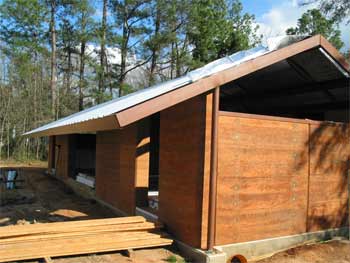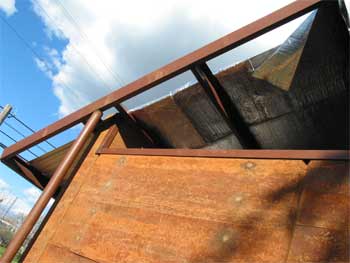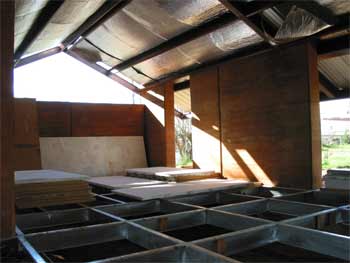In 1943, Clara Alexander of Salem, Missouri, began constructing her rammed earth home. The overseer of the construction was Guy Eveland, a concrete and masonary expert. He had learned of the feasibility of this type of structure when he observed several of these houses while in France during World War I.
Alabama Rammed Earth



Designed by former students of the Rural Studio, this rammed earth house in Greensboro, Alabama has several interesting features. The walls of the house are not load-baring. The roof is supported by steel columns at the corners and the earth wall slides upwards between two steel beams on which the rafters sit. The floor is constructed with what seem to be foam sandwiched plywood flooring on large steel joists.
Robot May Build with Mud
In a laboratory in Los Angeles early this year, a robot armed with a concrete pump built its first wall. Just a small wall, about a yard wide, a foot high and an inch thick, but beautifully formed in a graceful oval sweep. Iranian born engineer Behrokh Khoshnevis has tested his prototype with cement but believes adobe, a mix of mud and straw that is dried by the Sun, could be suitable. The chief advantages of the Contour Crafting process over existing technologies are the superior surface finish that is realized and the greatly enhanced speed of fabrication. The success of the technology stems from the automated use of age-old tools normally wielded by hand, combined with conventional robotics and an innovative approach to building three-dimensional objects that allows rapid fabrication times. Professor Khoshnevis believes that his technology will make it possible to build a house from foundation to roof in less than 24 hours: “Our goal,” he says, “is to be able to completely construct a one-storey 185-square-metre home on site in one day, without using human hands.”
Juana Briones Historic House

Juana Briones was known as a healer who raised a big family, opened her door to many in need and persevered to win a divorce from an abusive husband — something unheard of in the early 1800s. In 1844 she bought the 4,400-acre Rancho La Purisima Concepcion and lived there until not too long before her death in 1889. What Briones advocates have been trying to do for several years now is preserve the part of the house that’s built of a very unusual construction called encajonado, an old rammed-earth technique that exists in only three other houses in California. On the Juana Briones Heritage Foundation Website, the house is described as Palo Alto’s oldest, with a construction date of 1846. In May a judge is expected to issue a decision that will make the difference between a house repaired and a house demolished.
Call for Papers and Conference Announcement
The Second Annual Conference of the Adobe Association of the Southwest will take place May 21, 22 and 23 in El Rito, New Mexico on the campus of Northern New Mexico Community College.
Call for Papers Schedule:
One page (maximum) abstract due March 23, 2004
Notification of acceptance March 31, 2004
Full paper (5-page maximum) due April 23, 2004 for conference prepublication.
Presenters will have 20 minutes for presentation and 10 minutes to answer questions. Time limits will be carefully monitored.
The host institution can accomodate 2×2 slides in Carousels or Microsoft PowerPoint Presentations.
Topics of special interest are:
Affordable adobe construction
Thermal properties of earthen materials
Historical buildings of note in the United States
Historical builders of note in the United States
Historical architects/designers of note
Historical developers/planners of note
New projects
Adobe education
Manufacture and supply of construction materials
Conference Schedule:
Friday, May 21, 2004
11AM to 1PM Registration
1:30PM to 4:30 PM Session I
5PM to 6:30PM Dinner
7PM to 9PM Social Hour
Saturday, May 22, 2004
9:30AM to 12M Session II
1:30PM to 5PM Tour
7PM to 9PM Session III
Sunday, May 23, 2004
9:30AM to 12M Session IV
Northern New Mexico Community College has dorm rooms, suites, and a cafeteria available at very reasonable prices. Contact Donald Martinez for reservations at 505-581-4120 or donmart@mail.nnmcc.edu
The Conference registration cost is $30 for Association members and $45 for non-members. For more information contact Quentin Wilson at 505-581-4156 or qwilson@mail.nnmcc.edu
Clay – The Eternal Stuff Of Building
Mud is almost too basic to talk about, but humans have used it for more than 15,000 years to build things, so its value is inestimable. And, since most clay is free – there’s no commercial market (outside of artists’ specialty clays) competing for your dollars.
Texas Rammed Earth/South Carolina Origins
Southwest School of Art & Craft, with roots dating to 1848, when the Catholic community started building the Ursuline Academy, an elite, private girl’s school, it is one of the oldest education sites in San Antonio, Texas. It was recently declared the largest and most significant example of French-influenced architecture in the state by the French Heritage Society. Early buildings on the campus were designed by famed architect Francois Giraud, the city’s first surveyor who is responsible for many of the city’s distinct buildings, including the French Gothic style addition of San Fernando Cathedral. Giraud, who was born in South Carolina to French immigrant parents, chose a construction method called pise de terre, or rammed earth, for the buildings. Skilled pise worker Jules Poinsard worked as a subcontractor on the project.
Rare Earth: The Weir Brothers
This article is published with the permission of the author, Thomas Shess, who is a San Diego based free-lance writer, who has been specializing in period homes from Adobe to Post Modern for more than 30 years. The article will appear in the March 2004 issue of San Diego By Design.
RARE EARTH
A Fifties-Era Adobe Redo in La Mesa
Southern California’s romance with red-tiled Spanish influenced architecture shows no sign of ebbing. Sharp eyed aficionados can drive any local residential street and see variation upon variation of this warm and comfortable style whether it is Mission, Monterrey, Rancho Hacienda, or Pueblo Revival. This month’s featured home in La Mesa is a fine example of Adobe construction, one of the rarer Spanish revival themes around.
When Ad/PR execs Rob Akins and Mark Berry purchased their 1957 custom adobe home in the foothills of La Mesa, the home was a diamond in the rough waiting to be given new life. The owners named their home Casa dos Palmas after the two towering palms in the back yard and set out to accentuate the warm, rustic charm of the place, with its generous rooms, multiple fireplaces, high beamed ceilings and panoramic views, by infusing an international look with contemporary furnishings, extensive art and custom lighting.
“The house was classic Weir Brothers design – soaring open beams of solid cedar, 16″ thick walls of adobe and artisan fireplaces. It was also dark, dated and with little connection to the outdoors,” said Akins. “We wanted to create a home that was an extension of the outdoors.” Removing the original 50’s patio doors and windows, the owners installed custom wood French doors and windows with bronze hardware. Simple Sautillo tile replaced dated shag carpeting, while sisal carpeting went into bedrooms and hallways. Graphic designer Berry designed the back yard with a dramatic pool, terrace, deck and outdoor dining pavilion (featured in San Diego Magazine June, 2000 issue) that takes in the 280? view of the eastern mountains. Abundant landscaping creates privacy as well as providing color to the mini-compound.
Brothers Jack and Larry Weir worked together after WWII to the 1960’s building adobe homes in Escondido, Pala, Fallbrook, Pauma Valley and La Mesa. After the war when building materials were scarce, Jack Weir built a home out of “dirt cheap” adobe bricks for his then young family. When some post war house hunter offered Jack $15,000 for that first home a thriving custom home building business using mud bricks was founded and flourished into the 1960s.
Casa dos Palmas like other thick-walled adobe structures provides an environment that is cool in the summer and warm in the winter. While adobe remains an economical building material recent adobe construction in the U.S. has seen better days. Reason is modern seismic building codes have blunted adobe construction for most of the past half century.
Recently, Akins and Berry purchased a small farm in Sonoma County, moved into their condo on Balboa Park and sold Casa dos Palmas to architect Jim Tanner and wife Annemarie Eckhardt, who split their time between San Diego and San Francisco. Tanner is partners in TannerHecht [cq]Architecture, the designers of several high profile projects in San Diego including ICON at the former Reincarnation building. As fate would have it, Tanner and business partner David Hecht have started designing Akins and Berry’s Sonoma home which features a newly planted olive grove as its focal point. Splitting their time between San Diego and Sonoma County, now Akins and Berry have the best of both worlds – a Town & Country lifestyle that suits them just fine.
Khalili Wants To Build in Space
Great site, was just reading and doing some work when I found this page
Quentin Branch Rammed Earth
Quentin Branch, the rammed earth builder for architects Rick Joy and Jones Studio, has a very informative website that includes photos, workshop offerings and video.
